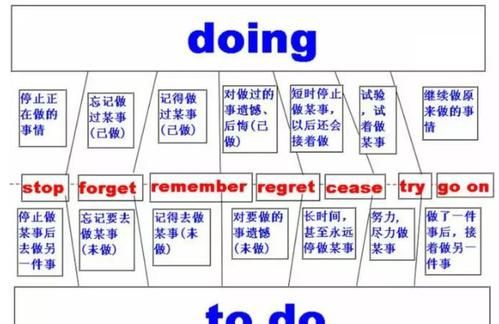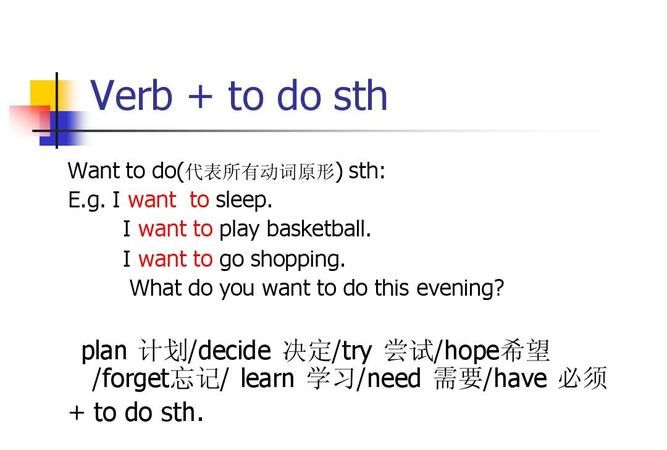本文目录
英语翻译
一般来说,to
do表示一件事还没完成,
doing则表示这事已经做完了

to do放在句子开头
to do 表示目的,比如To get a good result ., I will work hard . doing用法比较多,一般没什么特殊用法,都是这样用,Playing while study is interesting .例: do 是表示祈使,用于命令类的,例:close the door .

动词后加to do和doing的区别
to do 和doing的用法区别
stop to do 停止,中断做某事后去做另一件事.
stop doing 停止做某事.
They stop to smoke a cigarette. 他们停下来,抽了根烟.
I must stop smoking. 我必须戒烟了.
典型例题
She reached the top of the hill and stopped ___ on a big rock by the side of the path.
A. to have rested B. resting C. to rest D. rest
答案:C.由题意可知,她到了山顶,停下来在一个路边的大石头上休息.因此,应选择"stop to do sth. 停下来去做另一件事".而不仅仅是爬山动作的终止,所以stop doing sth.不正确.
forget to do 忘记要去做某事. (未做)
forget doing 忘记做过某事. (已做)
The light in the office is stil on. He forgot to turn it off.
办公室的灯还在亮着,它忘记关了.(没有做关灯的动作)
He forgot turning the light off.
他忘记他已经关了灯了. ( 已做过关灯的动作)
Don't forget to come tomorrow.
别忘了明天来. (to come动作未做)
典型例题
---- The light in the office is still on.
---- Oh,I forgot___.
A. turning it off B. turn it off C. to turn it off D. having turned it off
答案:C.由the light is still on 可知灯亮着,即关灯的动作没有发生,因此用forget to do sth.
而forget doing sth表示灯已经关上了,而自己忘记了这一事实.此处不符合题意.
remember to do 记得去做某事 (未做)
remember doing 记得做过某事 (已做)
Remember to go to the post office after school.
记着放学后去趟邮局.
Don't you remember seeing the man before?
你不记得以前见过那个人吗?
regret to do 对要做的事遗憾. (未做)
regret doing 对做过的事遗憾、后悔. (已做)
I regret to have to do this, but I have no choice.
我很遗憾必须这样去做,我实在没有办法.
I don't regret telling her what I thought.
我不为告诉她我的想法而后悔.
典型例题
---You were brave enough to raise objections at the meeting.
---Well, now I regret ___ that.
A. to do B. to be doing C. to have done D. having done
答案:D.regret having done sth. 对已发生的事感到遗憾.regret to do sth. 对将要做的事感到遗憾.本题为对已说的话感到后悔,因此选D.
cease to do 长时间,甚至永远停做某事.
cease doing 短时停止做某事,以后还会接着做.
That department has ceased to exist forever.
那个部门已不复存在.
The girls ceased chatting for a moment when their teacher passed by.
姑娘们在老师走过时,停了会聊天.
try to do 努力,企图做某事.
try doing 试验,试着做某事.
You must try to be more careful.
你可要多加小心.
I tried gardening but didn't succeed.
我试着种果木花卉,但未成功.
go on to do 做了一件事后,接着做另一件事.
go on doing 继续做原来做的事.
After he had finished his maths,he went on to do his physics.
做完数学后,他接着去做物理.
Go on doing the other exercise after you have finished this one.
作完这个练习后,接着做其他的练习.
be afraid to do 不敢,胆怯去做某事,是主观上的原因不去做,意为"怕";
be afraid of doing 担心出现doing的状况、结果. doing 是客观上造成的,意为"生怕,恐怕".
She was afraid to step further in grass because she was afraid of being bitten by a snake.
她生怕被蛇咬着,而不敢在草丛中再走一步.
She was afraid to wake her husband.
她不敢去叫醒她丈夫.
She was afraid of waking her husband.
她生怕吵醒她丈夫.
interested to do 对做某事感兴趣,想了解某事.
interested in doing 对某种想法感兴趣,doing 通常为想法.
I shall be interested to know what happens.
我很想知道发生了什么事. (想了解)
I'm interested in working in Switzerland. Do you have any idea about that?
我对在瑞士工作感兴趣.你想过这事吗? (一种想法)
mean to do 打算、想
mean doing 意味着
I mean to go, but my father would not allow me to.
我想去,但是我父亲不肯让我去.
To raise wage means increasing purchasing power.
赠加工资意味着增加购买力.
begin / start to do sth
begin / start doing sth.
1) 谈及一项长期活动或开始一种习惯时,使用doing.
How old were you when you first started playing the piano?
你几岁时开始弹钢琴?
2) begin, start用进行时时,后面动词用不定式to do
I was beginning to get angry.
我开始生起气来.
3) 在attempt, intend, begin, start 后接know, understand, realize这类动词时,常用不定式to do.
I begin to understand the truth.
我开始明白真相.
4) 物作主语时
It began to melt.
感官动词 see, watch, observe, notice, look at, hear, listen to, smell, taste, feel + do 表示动作的完整性,真实性;+doing 表示动作的连续性,进行性
I saw him work in the garden yesterday.
昨天我看见他在花园里干活了.(强调"我看见了"这个事实)
I saw him working in the garden yesterday.(强调"我见他正干活"这个动作)
昨天我见他正在花园里干活.
典型例题
1)They knew her very well. They had seen her ___ up from childhood.
A. grow B. grew C. was growing D. to grow
答案:A.因题意为,他们看着她长大,因此强调的是成长的过程,而非正在长的动作,因此用see sb do sth 的句型.
2)The missing boy was last seen ___ near the river.
A. playing B. to be playing C. play D. to play
答案A. 本题强调其动作,正在河边玩,应此用see sb. doing sth句型.
1.stop to do 停止,中断做某事后去做另一件事。
stop doing 停止做某事。
2.forget to do 忘记要去做某事。
forget doing 忘记做过某事。
3.remember to do 记得去做某事
remember doing 记得做过某事
4.regret to do 对要做的事遗憾。
regret doing 对做过的事遗憾、后悔。
5.cease to do 长时间,甚至永远停做某事。
cease doing 短时停止做某事,以后还会接着做。
6.try to do 努力,企图做某事。
try doing 试验,试着做某事。
7.go on to do 做了一件事后,接着做另一件事。
go on doing 继续做原来做的事。
8.begin / start to do sth
begin / start doing sth.

英语to do 和doing怎样区分用
do做 一般的做都是用这个 to do去做 想要做什么事情的时候用to do,将要去做什么事情也是用to do doing正在做 无论是现在过去甚至是将来 表示动作正在进行就用doing do前边没有介词或者其他词 to do前面可以有be或者没有 doing前有be动词 感官动词

以上就是关于怎么判断todo还是doing ,英语翻译的全部内容,以及怎么判断todo还是doing 的相关内容,希望能够帮到您。

